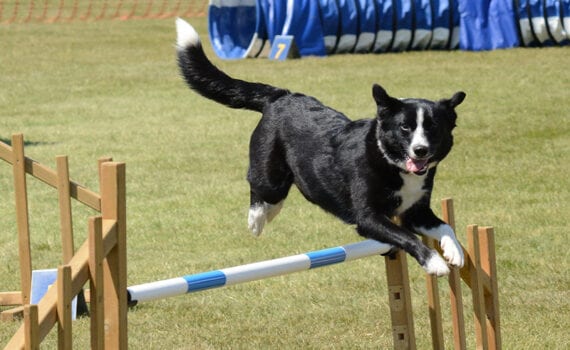
How to Introduce Athletic Activities to Your Canine
By Carol Kendig
Pampered Pooch or Canine Athlete?
Some pets are pampered couch-potatoes, happy with two meals and 2 rambling walks a day. But there is a growing segment of people who are involving their pets in competitive canine sports and activities. These elite canine athletes, like their human counterparts, have special needs that must be met for their well-being.
Optimize Their Performance
Breed Matters
When choosing a sport consider your dog’s breed or combination of breeds. Of course, there are exceptions to every rule, but your Bullmastiff might do better at Rally and Nose Work rather than Dock Diving. Your Ibizan Hound might prefer Lure Coursing, your German Shepherd would excel at Parkour, a Labrador makes an excellent service dog, and an Australian Shepherd is born to Herd. But you don’t need to limit your ideas to the obvious. Often individual dogs in a breed and especially mixed breeds will surprise us with their versatility. Know your dog, investigate various sports, and choose a few that you and your dog might enjoy.
Pre-Conditioning
Before leaping into a vigorous sport with your dog, you and your pet may need to do some pre-conditioning. Check with your local canine fitness instructors for classes or seminars. These experts can advise you on sports that may be appropriate for your dog and direct you with the appropriate conditioning. You will learn a lot from these experts and have fun developing skills that will enhance your dog’s performance.
Nutrition
Along with a training routine, optimal nutrition is a must. Canine parents need to be aware that selection of foods and fluids, timing of intake, and supplement choices will influence their dog’s performance. Energy and macronutrient needs, (carbohydrates, fats, and proteins), must be met during times of high physical activity to maintain body weight, replenish glycogen stores, and provide adequate fuel to build and repair tissue.
In raw fed dogs, fat is the primary energy source. Kibble fed dogs mainly use carbohydrates for energy which is less effectively metabolized by the canine digestive system. Fat intake is also important for essential fatty acids, fat-soluble vitamins, and for weight maintenance, all important elements for your athlete. And if your dog’s food contains appropriate animal fats, it is also quite tasty to him. Many parents of top canine athletes are feeding a raw food diet to their dogs, finding increased energy, weight normalization, and joint support among the numerous benefits.
A Balanced Diet & Body Weight
Although exercise performance can be affected by body weight and composition, these physical measurements should not be a criterion for sports performance and daily weigh-ins are discouraged. Vitamin and mineral supplements are not needed if they consume a variety of foods which provide adequate energy to maintain desired body weight. However, if you are restricting your dog’s diet, eliminating one or more food groups, or feeding an unbalanced diet with low micronutrient density, your dog may need added supplementation. Finding a holistic veterinarian with experience in canine nutrition will be a worthwhile addition to your team.
Treat-ment of Your Canine Athlete
Warm-up and cool-down activities are important for your dog and helpful exercises can be suggested by your canine fitness instructor. Be aware that hydration and treat rewards should be carefully monitored before and after vigorous sports. Each type of sport has different requirements. For example, sprinting athletes do better with a treat after exercise while endurance athletes need higher nutrition prior to events. Most of our dogs fall into the intermediate athlete range and treats can be fed more liberally. And always consider the possibility of bloat which is more common but not limited to the deep chested breeds. Heed your vet’s advice on avoiding this deadly condition.
Fun Activity or Competition – It’s All Good
If you like the idea of participating in canine sports and activities; if you think your dog might be a candidate for one of the multitudes of choices; go for it! Working together to perfect techniques and enjoying an exciting day of competition will only strengthen and deepen the bond you already have with your dog. Whether leaping high off the dock or burrowing underground after prey, your dog’s enthusiastic joy will gladden your heart. And at the end of an active day, two tired best buddies will be ready to go home and begin again tomorrow.
Carol Kendig, Patti Salladay 2020